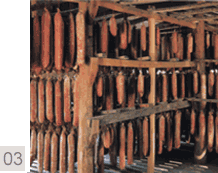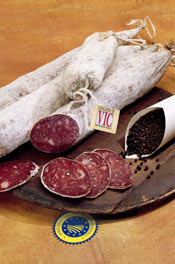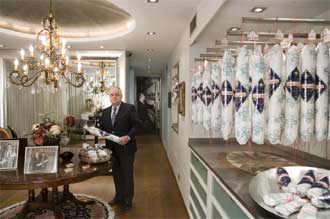
Teresa Parker blogs about restaurants, recipes, and the reasons why she's in love with Spain's food and culture.
 If you read Bill Buford's Heat, you know that Mario Batali's first formative food epiphany came in Spain. Too bombed to recall the specifics, he later moved on, slightly more soberly, to Italy. Now PBS has him roving Spain in the company of Gwyneth Paltrow, filming their culinary road trip for TV. Mark Bittman is along too, presumably to eat for Gwyneth. Stalking along on Batali's blog, I started to worry that Mario, GP and Bitty's "discovery" of Vic's beloved sausage, the llonganissa, might make it impossible to keep production at artisanal levels.
If you read Bill Buford's Heat, you know that Mario Batali's first formative food epiphany came in Spain. Too bombed to recall the specifics, he later moved on, slightly more soberly, to Italy. Now PBS has him roving Spain in the company of Gwyneth Paltrow, filming their culinary road trip for TV. Mark Bittman is along too, presumably to eat for Gwyneth. Stalking along on Batali's blog, I started to worry that Mario, GP and Bitty's "discovery" of Vic's beloved sausage, the llonganissa, might make it impossible to keep production at artisanal levels.  A purist's salami, llonganissa is made from choice cuts of pork, {C}only hams, loins, and bellies; the meat is diced, not ground; it is seasoned only with salt and black pepper. After a 48 hour cold maceration, the meat is packed in natural casings, and the sausage is cured in Vic's curiously foggy air for at least 45 days. That dusting of white on the skin isn't some painted on powder -- it's a coveted kind of mold. Not available in the U.S., this sausage has cult status in the region. It's worth a trip (maybe literally, at around 35 Euros a kilo).
A purist's salami, llonganissa is made from choice cuts of pork, {C}only hams, loins, and bellies; the meat is diced, not ground; it is seasoned only with salt and black pepper. After a 48 hour cold maceration, the meat is packed in natural casings, and the sausage is cured in Vic's curiously foggy air for at least 45 days. That dusting of white on the skin isn't some painted on powder -- it's a coveted kind of mold. Not available in the U.S., this sausage has cult status in the region. It's worth a trip (maybe literally, at around 35 Euros a kilo).  There are lots of sausage makers in Vic, and the displays at stores along Calle dels Argenters and C/ de Carnisseries ("butcher-shop row") are impressive. Some producers aim for I.G.P. status (Indicació Geogràfica Protegida), a European Union designation meaning the sausage is made according to standards of local-ness, seasoned and shaped in a traditional style, but not necessarily with purely local ingredients. Others go for their own family's versions, I.G.P be damned. Batali tasted two great sausages from renowned producers. Casa Riera Ordeix (est. 1852) has the I.G.P. designation. Spiffy as it is, the factory Batali saw was not actually a "full-on USDA cleaning and chopping place," let's just say this stuff is too carefully made to be USDA approved. Joaquín Comella of Riera Ordeix confirmed that although they've observed with interest the arrival of the great Spanish ibérico hams on the US market, they aren't yet near that point. They're purists here: no nitrites, no plastic casings, and classy pork. "We raise our own pigs, and use only sows," which, because they're of a certain age, "gives our sausage its deeper characteristic color and flavor - the young pork people are used to now is pallid by comparison," he says.
There are lots of sausage makers in Vic, and the displays at stores along Calle dels Argenters and C/ de Carnisseries ("butcher-shop row") are impressive. Some producers aim for I.G.P. status (Indicació Geogràfica Protegida), a European Union designation meaning the sausage is made according to standards of local-ness, seasoned and shaped in a traditional style, but not necessarily with purely local ingredients. Others go for their own family's versions, I.G.P be damned. Batali tasted two great sausages from renowned producers. Casa Riera Ordeix (est. 1852) has the I.G.P. designation. Spiffy as it is, the factory Batali saw was not actually a "full-on USDA cleaning and chopping place," let's just say this stuff is too carefully made to be USDA approved. Joaquín Comella of Riera Ordeix confirmed that although they've observed with interest the arrival of the great Spanish ibérico hams on the US market, they aren't yet near that point. They're purists here: no nitrites, no plastic casings, and classy pork. "We raise our own pigs, and use only sows," which, because they're of a certain age, "gives our sausage its deeper characteristic color and flavor - the young pork people are used to now is pallid by comparison," he says.  Casa Sendra (est. 1849) is a statement, tricked out like a jewelry shop by owner Pau Arboix, who has been profiled in El Pais as a stalwart against the sausage-making's unfortunate reputation for "sordidness." (They don't have a website. Go see and taste in person at C/Jacint Verdeguer, 23, Vic.) Mr. Arboix told me he refuses to "play the I.G.P. game," because, he says, "It has no real meaning in terms of quality." In his view, the designation panders to cheap mass producers in its vagueness. "Worst of all, it allows the use of additives such as nitrites, which are known carcinogens," he says. This sausage was awarded Le Guide des Gourmands' Coq d'Or for "Best Food in Spain" in 2006. Besides using only the requisite choice cuts, Arboix says the pork he uses comes from pigs fattened within 10km of Vic. He founded his own slaughterhouse to gain full control of production: "For any given batch of sausage, I can tell you exactly where the pigs were raised, what they ate, and, by the way, that means grains and vegetables -- not a bunch of animal byproducts and antibiotics." Making real llonganissa, he says is "simply incompatible with mass production."
Casa Sendra (est. 1849) is a statement, tricked out like a jewelry shop by owner Pau Arboix, who has been profiled in El Pais as a stalwart against the sausage-making's unfortunate reputation for "sordidness." (They don't have a website. Go see and taste in person at C/Jacint Verdeguer, 23, Vic.) Mr. Arboix told me he refuses to "play the I.G.P. game," because, he says, "It has no real meaning in terms of quality." In his view, the designation panders to cheap mass producers in its vagueness. "Worst of all, it allows the use of additives such as nitrites, which are known carcinogens," he says. This sausage was awarded Le Guide des Gourmands' Coq d'Or for "Best Food in Spain" in 2006. Besides using only the requisite choice cuts, Arboix says the pork he uses comes from pigs fattened within 10km of Vic. He founded his own slaughterhouse to gain full control of production: "For any given batch of sausage, I can tell you exactly where the pigs were raised, what they ate, and, by the way, that means grains and vegetables -- not a bunch of animal byproducts and antibiotics." Making real llonganissa, he says is "simply incompatible with mass production."Blog Category:
